Oberth Maneuver or natural flight path? 3I/ATLAS’s solar approach raises new questions
-
 BIG PINE, CALIFORNIA - OCTOBER 12: Comet Tsuchinshan-ATLAS appears over the Eastern Sierra mountains as it transitions into the evening sky shortly after sunset, as seen from the Ancient Bristlecone Pine Forest area, on October 12, 2024 near Big Pine, California. The coma, or comet head, measures approximately 130,000 miles (209,000 kilometers) in diameter and the tail stretches out for about 18 million miles (29 million km). The comet will not return for another 80,000 years. (Photo by David McNew/Getty Images)
BIG PINE, CALIFORNIA - OCTOBER 12: Comet Tsuchinshan-ATLAS appears over the Eastern Sierra mountains as it transitions into the evening sky shortly after sunset, as seen from the Ancient Bristlecone Pine Forest area, on October 12, 2024 near Big Pine, California. The coma, or comet head, measures approximately 130,000 miles (209,000 kilometers) in diameter and the tail stretches out for about 18 million miles (29 million km). The comet will not return for another 80,000 years. (Photo by David McNew/Getty Images)3I/ATLAS, the object scientists witnessed in our solar system lately, after it crossed an unusual path, has kept researchers on a hook as an event called ‘’solar conjunction’’ occurred when it moved behind the Sun. On October 21, 2025, the ‘’interstellar object’’ 3I/ATLAS moved behind the sun, making it invisible from Earth. Soon after, the object went out of sight and moved to its next point, which was close enough to the Sun (a spot called perihelion) on October 29, 2025.
Earlier, Avi Loeb confirmed this event will happen, where he wrote in his blog (via EurAsia Daily),
"When will 3I/ATLAS reach the optimal time for Obert maneuvers? Just eight days after joining the Sun. On October twenty—ninth, 2025, 3I/ATLAS will reach perihelion at 203 million kilometers.’’
3I/ATLAS begins debates whether its movement is part of a natural orbit or if it’s performing an Oberth Maneuver
As the object moves closer to the Sun, some people are wondering if it’s moving naturally through space or if it’s using a planned move called an Oberth Maneuver (a special technique where a spacecraft speeds up by using the Sun’s gravity). With that, rumors even started to swirl around the internet, where people began to suspect the object to be an ‘’alien mothership.’’
If we take a look at the Oberth effect, it claims that when a spacecraft is closer to a massive object, it could either speed up or slow down the most if it uses its engines. That’s because at that point, the spacecraft is moving the fastest, so burning fuel then gives it more power and energy.
So, this hideout behind the sun raises questions about whether 3I/ATLAS was built by aliens (an ETI extraterrestrial intelligence), which might be using this perfect moment near the Sun to perform a strong engine move, called an Oberth maneuver. So, if the theory leans more towards this, it would rule out the possibility that the object is following a natural flight path (where an object moves through space only because of gravity, without any engines or any other external forces).
What do the researchers believe, and how do they plan to go further in investigating 3I/ATLAS
This interstellar object stands out as it features some unusual characteristics, and Avi Leob shared a few reasons hinting that 3I/ATLAS might not be natural. First, its trajectory (path) aligned with the planets’ orbit. Second, its gas jets pointed toward the Sun, unusual content from its gas plume, and more importantly, it came from the same direction as the famous radio “Wow! Signal” once detected from space.
According to the scientist, if 3I/ATLAS is a big carrier ship, it will keep moving on its normal path and later leave the Solar System. Leob said in his blog,
"In this case, the Oberth maneuver can be applied to mini-probes that it launches at perihelion to the planets of the Solar system.''
Scientists had a chance to learn more about the interstellar object, but due to its hiding behind the sun, it was not possible. Generally, comets give off gas and dust when the Sun’s heat melts their surface, and 3I/ATLAS was doing the same. The amount of gas it released depended on how near it got to the Sun. This could help scientists learn where it came from.
TOPICS: 3I/ATLAS
- Interstellar comet 3I/ATLAS: From 2025 discovery to global sensation – now heading beyond Earth
- Europa Clipper spends seven hours watching 3I/ATLAS as NASA studies elements in its surrounding plume
- Harvard Professor Avi Loeb weighs evidence and interpretation surrounding anomalies in 3I/ATLAS
- Erratic rotation detected as MAVEN Mars probe remains silent